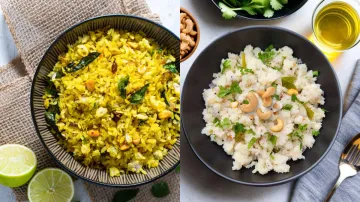Choosing the right breakfast is crucial for maintaining energy levels and promoting overall health. Two popular Indian breakfast options, Poha and Upma, often come up in discussions about healthy eating. Both dishes are delicious and nutritious, but how do they compare in terms of health benefits? Let's dive into the details to determine which is the healthier choice.
Poha
Ingredients: Poha, also known as flattened rice, is typically prepared with flattened rice flakes, peanuts, curry leaves, mustard seeds, onions, turmeric, and green chillies. Some variations include potatoes, peas, and other vegetables.
Nutritional Value: Poha is rich in carbohydrates, providing a quick source of energy. It's also a good source of iron, especially when prepared with ingredients like peanuts and vegetables. Poha is low in calories, making it an excellent choice for weight management.
Health Benefits:
- Rich in Iron: Poha is a good source of iron, essential for preventing anaemia and maintaining healthy blood levels.
- Easily Digestible: The light and fluffy texture of Poha makes it easy to digest, suitable for all age groups.
- Low in Calories: Poha is low in calories, which helps in managing weight while keeping you full for longer.
Upma
Ingredients: Upma is made from semolina (rava or suji), cooked with water and seasoned with mustard seeds, curry leaves, green chillies, onions, and sometimes vegetables like carrots, peas, and beans. It is often garnished with coconut, coriander, and lemon juice.
Nutritional Value: Upma is a good source of carbohydrates, providing sustained energy throughout the morning. It contains essential vitamins and minerals, including B vitamins, iron, and magnesium. When prepared with vegetables, it becomes a fiber-rich meal.
Health Benefits:
- Rich in Fibre: The addition of vegetables increases the fibre content of Upma, aiding in digestion and promoting a feeling of fullness.
- Energy Booster: The carbohydrates in semolina provide a steady release of energy, keeping you active and alert.
- Nutrient-Dense: Upma can be enriched with various vegetables and nuts, making it a nutrient-dense meal.
Poha vs Upma:
Calorie Count:
If you're watching your calorie intake, poha might be the better choice. Its lighter texture translates to fewer calories per serving. Upma, however, can be made lighter by using less oil and opting for vegetables instead of heavier ingredients.
Protein Power:
Athletes and those seeking a protein boost might favour upma. Sooji boasts a higher protein content than flattened rice, making it a more filling and muscle-building option. Upma is also a good source of B-complex vitamins, beneficial for vegetarians and vegans who might struggle to get enough protein from other sources.
Glycemic Index:
Poha has a moderate glycemic index, making it suitable for maintaining stable blood sugar levels. On the other hand, upma has a lower glycemic index compared to Poha, beneficial for sustained energy release and blood sugar management.
Digestibility:
Both dishes are generally easy to digest. However, poha's light and fluffy texture might be gentler on sensitive stomachs.
Which is Healthier?
Both Poha and Upma have their unique health benefits, and the healthier option depends on individual nutritional needs and preferences.
For Weight Management: Poha, with its lower calorie content, might be a better choice for those looking to manage their weight.
For Sustained Energy: Upma, with its higher fibre and nutrient content, could be more beneficial for sustained energy release and overall nutrient intake.
Ultimately, both Poha and Upma can be part of a healthy, balanced diet. Including a variety of vegetables, nuts, and seeds in either dish can enhance their nutritional profiles. The key is moderation and diversity in your breakfast choices to ensure you get a wide range of nutrients to start your day right.
ALSO READ: Filter Coffee vs Araku Coffee: Which brew is healthier?
